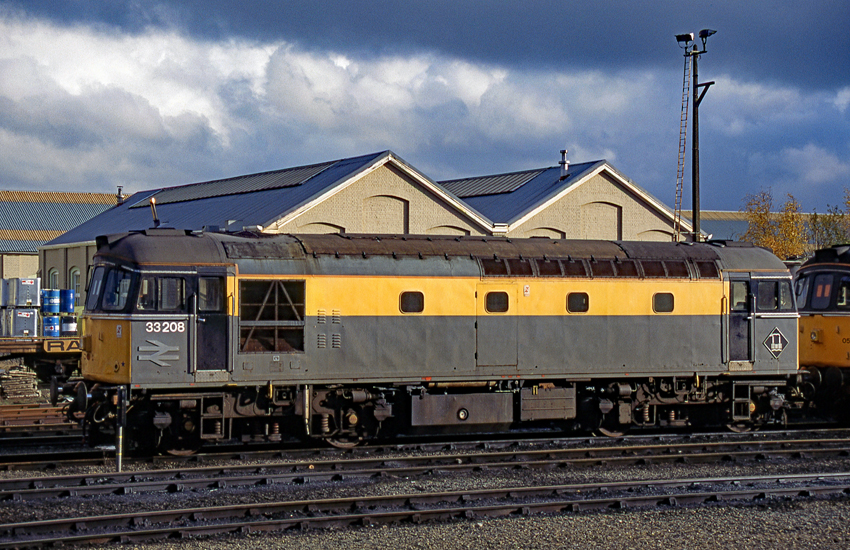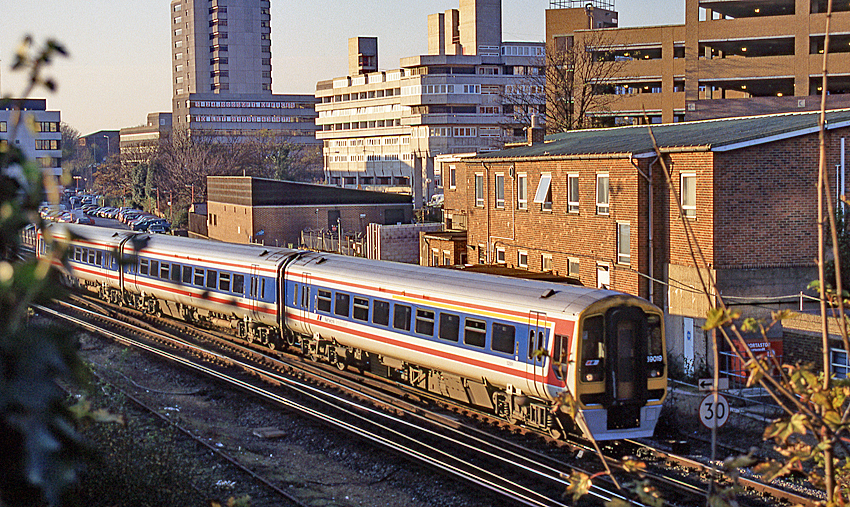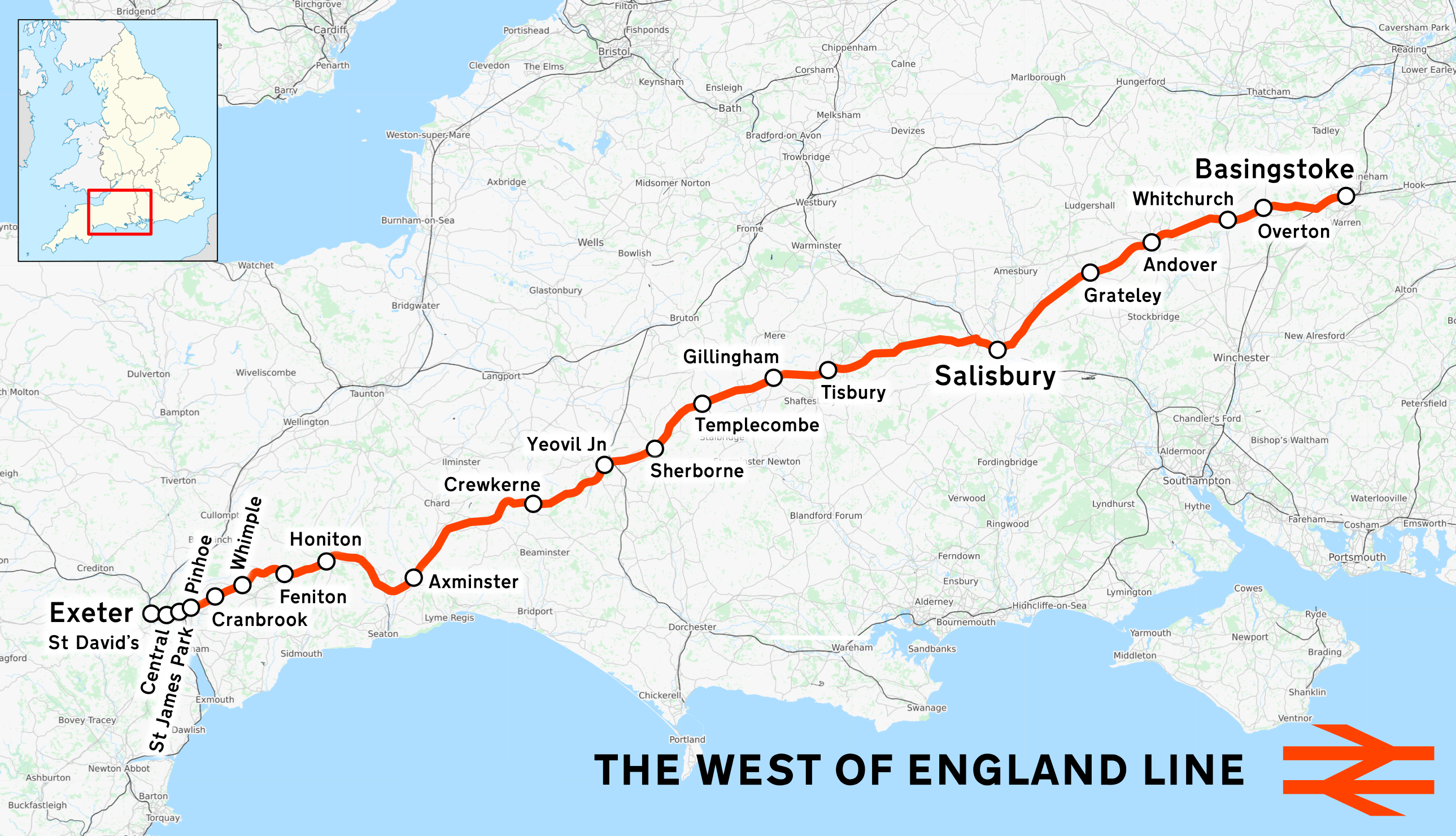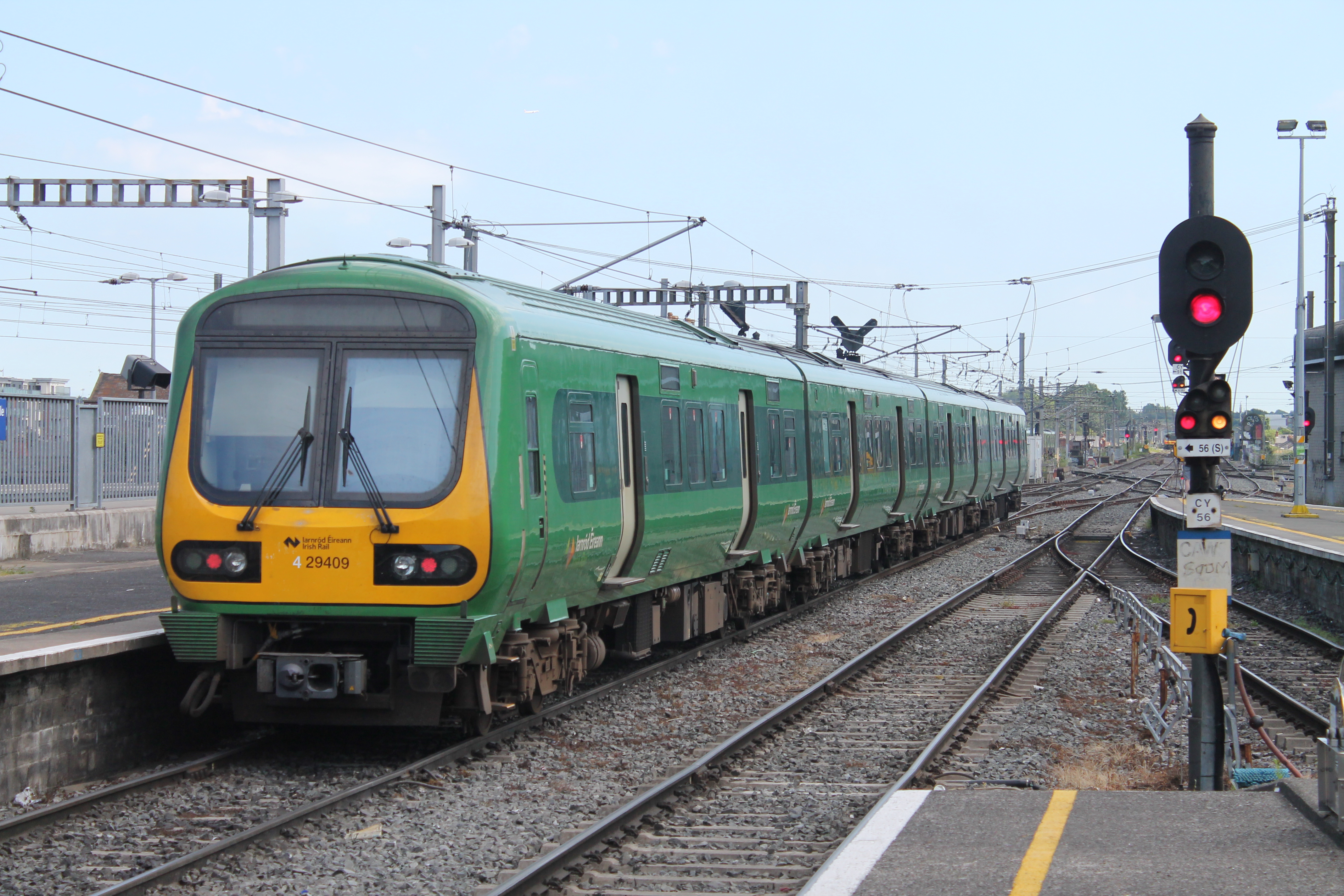|
Salisbury TMD
Salisbury TMD is the South Western Railway traction maintenance depot in Salisbury, Wiltshire, England, situated on the north side of Salisbury railway station. It opened in 1992 to maintain the fleet of DMUs used on the West of England line. History The depot is built on the site of the former Great Western Railway (GWR) station, opened in 1856. A two-road engine shed was provided on the south side of the site but was moved westwards in 1899 to allow the London and South Western Railway (LSWR) to expand their adjacent station. This company originally had an engine shed at their Milford station on the opposite side of the city from 1847, which was relocated to a site opposite the GWR shed when the LSWR opened their new station in 1859. This three-road shed was closed around 1901 and moved to a new larger site further west from the station at Cherry Orchard Lane. This new facility had ten roads. It closed in June 1967 but was used to store withdrawn locomotives for a short ti ... [...More Info...] [...Related Items...] OR: [Wikipedia] [Google] [Baidu] |
Salisbury
Salisbury ( ) is a cathedral city in Wiltshire, England with a population of 41,820, at the confluence of the rivers Avon, Nadder and Bourne. The city is approximately from Southampton and from Bath. Salisbury is in the southeast of Wiltshire, near the edge of Salisbury Plain. Salisbury Cathedral was formerly north of the city at Old Sarum. The cathedral was relocated and a settlement grew up around it, which received a city charter in 1227 as . This continued to be its official name until 2009, when Salisbury City Council was established. Salisbury railway station is an interchange between the West of England Main Line and the Wessex Main Line. Stonehenge is a UNESCO World Heritage Site and is northwest of Salisbury. Name The name ''Salisbury'', which is first recorded around the year 900 as ''Searoburg'' ( dative ''Searobyrig''), is a partial translation of the Roman Celtic name ''Sorbiodūnum''. The Brittonic suffix ''-dūnon'', meaning "fortress" (in reference ... [...More Info...] [...Related Items...] OR: [Wikipedia] [Google] [Baidu] |
British Rail Class 33
The British Rail Class 33, also known as the BRCW Type 3 or Crompton, is a class of Bo-Bo diesel-electric locomotives, ordered in 1957 and built for the Southern Region of British Railways between 1960 and 1962. They were produced as a more powerful Type 3 (1,550 bhp) development of the 1,160 bhp Type 2 Class 26. This was achieved, quite simply, by removing the steam heating boiler and fitting a larger 8 cylinder version of the previous 6 cylinder engine. This was possible because of the traffic requirements of the Southern Region: locomotive-hauled passenger traffic depended on seasonal tourist traffic and was heavier in the summer, when carriage heating was not needed. In the winter, their expected use was to be for freight. Thus, they became the most powerful BR Bo-Bo diesel locomotive. The perennially unreliable steam heating boiler could also be avoided. A total of 98 were built by the Birmingham Railway Carriage and Wagon Company (BRCW) and they were known as ... [...More Info...] [...Related Items...] OR: [Wikipedia] [Google] [Baidu] |
Railway Depots In England
Rail transport (also known as train transport) is a means of transport that transfers passengers and goods on wheeled vehicles running on rails, which are incorporated in Track (rail transport), tracks. In contrast to road transport, where the vehicles run on a prepared flat surface, rail vehicles (rolling stock) are directionally guided by the tracks on which they run. Tracks usually consist of steel rails, installed on Railroad tie, sleepers (ties) set in track ballast, ballast, on which the rolling stock, usually fitted with metal wheels, moves. Other variations are also possible, such as "slab track", in which the rails are fastened to a concrete foundation resting on a prepared subsurface. Rolling stock in a rail transport system generally encounters lower friction, frictional resistance than rubber-tyred road vehicles, so passenger and freight cars (carriages and wagons) can be coupled into longer trains. The rail transport operations, operation is carried out by a ... [...More Info...] [...Related Items...] OR: [Wikipedia] [Google] [Baidu] |
British Rail Class 158
The British Rail Class 158 '' Express Sprinter'' is a diesel multiple unit (DMU) passenger train. It is a member of the Sprinter series of regional trains, produced as a replacement for British Rail's first generation of DMUs; of the other members, the Class 159 is almost identical to the Class 158, having been converted from Class 158 to Class 159 in two batches to operate express services from London Waterloo to the West of England. The Class 158 was constructed between 1989 and 1992 by British Rail Engineering Limited (BREL) at its Derby Litchurch Lane Works. The majority were built as two-car sets, some three-car sets were also produced. During September 1990, the first Express Sprinters were operated by ScotRail; the type was promptly introduced to secondary routes across the Midlands, Northern England, Wales and the South West. The Class 158 enabled the replacement of large numbers of elderly DMUs but also several locomotive-hauled trains as well; this was partially a ... [...More Info...] [...Related Items...] OR: [Wikipedia] [Google] [Baidu] |
Diesel Multiple Unit
A diesel multiple unit or DMU is a multiple-unit train powered by on-board diesel engines. A DMU requires no separate locomotive, as the engines are incorporated into one or more of the carriages. Diesel-powered single-unit railcars are also generally classed as DMUs. Diesel-powered units may be further classified by their transmission type: diesel–mechanical DMMU, diesel–hydraulic DHMU, or diesel–electric DEMU. Design The diesel engine may be located above the frame in an engine bay or under the floor. Driving controls can be at both ends, on one end, or in a separate car. Types by transmission DMUs are usually classified by the method of transmitting motive power to their wheels. Diesel–mechanical In a diesel–mechanical multiple unit (DMMU), the rotating energy of the engine is transmitted via a gearbox and driveshaft directly to the wheels of the train, like a car. The transmissions can be shifted manually by the driver, as in the great majority of first-gen ... [...More Info...] [...Related Items...] OR: [Wikipedia] [Google] [Baidu] |
Salisbury TMD 159003 159017 159022 158887 960012
Salisbury ( ) is a cathedral city in Wiltshire, England with a population of 41,820, at the confluence of the rivers Avon, Nadder and Bourne. The city is approximately from Southampton and from Bath. Salisbury is in the southeast of Wiltshire, near the edge of Salisbury Plain. Salisbury Cathedral was formerly north of the city at Old Sarum. The cathedral was relocated and a settlement grew up around it, which received a city charter in 1227 as . This continued to be its official name until 2009, when Salisbury City Council was established. Salisbury railway station is an interchange between the West of England Main Line and the Wessex Main Line. Stonehenge is a UNESCO World Heritage Site and is northwest of Salisbury. Name The name ''Salisbury'', which is first recorded around the year 900 as ''Searoburg'' (dative ''Searobyrig''), is a partial translation of the Roman Celtic name ''Sorbiodūnum''. The Brittonic suffix ''-dūnon'', meaning "fortress" (in reference t ... [...More Info...] [...Related Items...] OR: [Wikipedia] [Google] [Baidu] |
London Waterloo Station
Waterloo station (), also known as London Waterloo, is a London station group, central London terminus on the National Rail network in the United Kingdom, in the Waterloo, London, Waterloo area of the London Borough of Lambeth. It is connected to a London Underground Waterloo tube station, station of the same name and is adjacent to Waterloo East station on the South Eastern Main Line. The station is the terminus of the South West Main Line to via Southampton, the West of England main line to Exeter via , the Portsmouth Direct line to which connects with ferry services to the Isle of Wight, and several commuter services around west and south-west London, Surrey, Hampshire and Berkshire. The station was opened in 1848 by the London and South Western Railway, and it replaced the earlier as it was closer to the West End of London, West End. It was never designed to be a terminus, as the original intention was to continue the line towards the City of London, and consequently t ... [...More Info...] [...Related Items...] OR: [Wikipedia] [Google] [Baidu] |
British Rail Class 159
The British Rail Class 159 is a class of British diesel multiple unit trains of the Sprinter family, built in 1989–1992 by British Rail Engineering Limited (BREL)'s Derby Litchurch Lane Works as Class 158. Before entering traffic, the original 22 units were modified at Rosyth Dockyard to Class 159 to operate services from London Waterloo to Salisbury and Exeter St Davids, replacing various locomotive-hauled passenger trains. The units were originally branded by Network SouthEast as South Western Turbo. History and design In the late 1980s, the locomotive-hauled stock on Network SouthEast's ''West of England'' route from London Waterloo to Salisbury, Yeovil Junction and Exeter St Davids was in urgent need of replacement. The Class 50 locomotives were not suited to the stop-start nature of the route, and frequently broke down. Because of the long sections of single track west of Salisbury following the Beeching cuts, a single breakdown could cause chaos. Various options we ... [...More Info...] [...Related Items...] OR: [Wikipedia] [Google] [Baidu] |
West Of England Main Line
The West of England line (also known as the West of England Main Line) is a British railway line from , Hampshire, to in Devon, England. Passenger services run between London Waterloo station and Exeter; the line intersects with the Wessex Main Line at . Despite its historic title, it is not today's principal route from London to the West of England: Exeter and everywhere further west are reached more quickly from London Paddington via the Reading–Taunton line. History Once all sections had been incorporated into the London and South Western Railway, the sections and branches were: * Basingstoke to Salisbury ** Basingstoke to Andover, opened 3 July 1854 ** Andover to Salisbury, opened 1 May 1857 ** Branches: ***''Basingstoke and Alton Light Railway'' opened June 1901, closed 30 May 1936 *** From Hurstbourne and Andover to Romsey and on to Eastleigh and Southampton: both closed. Link via Longparish opened 1 June 1885; closed 6 July 1931. *** At Andover, junction with the ... [...More Info...] [...Related Items...] OR: [Wikipedia] [Google] [Baidu] |
British Rail Class 50
The British Rail Class 50 is a class of diesel locomotives designed to haul express passenger trains at . Built by English Electric at the Vulcan Foundry in Newton-le-Willows between 1967 and 1968, the Class 50s were initially on a 10-year lease from English Electric Leasing, and were employed hauling express passenger trains on the, then non-electrified, section of the West Coast Main Line between Crewe and Scotland. Initially numbered D400–D449 and known as English Electric Type 4s, the locomotives were purchased outright by British Rail (BR) at the end of the lease and became Class 50 in the TOPS renumbering of 1973. The class gained the nickname "Hoovers" because of the noise made by the clean air plant at the No. 2 end, prior to refurbishment, which was likened to that of a vacuum cleaner, a name believed given to them by the staff at Paddington Station. Once the electrification from Crewe to Glasgow was completed the locomotives were moved to the Great Western Main Line ... [...More Info...] [...Related Items...] OR: [Wikipedia] [Google] [Baidu] |
British Rail Class 09
The British Rail Class 09 is a class of 0-6-0 diesel locomotive designed primarily for shunting and short-distance freight trips along branch lines. The 26 locos are nearly identical to the more numerous Class 08 shunting locomotives but have different gearing, giving a higher top speed of 27.5 mph (44 km/h) at the expense of a lower tractive effort. They were introduced from 1959 to 1962 and latterly operated in the Southern Region of British Railways, although some of the class were originally allocated to depots in the Midlands and North. Further locomotives were converted from Class 08 in 1992 and, following this and privatisation in 1997, the class has been distributed much further afield. Passenger operations Although not normally considered for passenger work, Class 09s were recorded working passenger trains between Clapham Junction and Kensington Olympia when the booked Class 33 diesel was unavailable. They were also used on Railtours which needed to depart ... [...More Info...] [...Related Items...] OR: [Wikipedia] [Google] [Baidu] |
Diesel Multiple Unit
A diesel multiple unit or DMU is a multiple-unit train powered by on-board diesel engines. A DMU requires no separate locomotive, as the engines are incorporated into one or more of the carriages. Diesel-powered single-unit railcars are also generally classed as DMUs. Diesel-powered units may be further classified by their transmission type: diesel–mechanical DMMU, diesel–hydraulic DHMU, or diesel–electric DEMU. Design The diesel engine may be located above the frame in an engine bay or under the floor. Driving controls can be at both ends, on one end, or in a separate car. Types by transmission DMUs are usually classified by the method of transmitting motive power to their wheels. Diesel–mechanical In a diesel–mechanical multiple unit (DMMU), the rotating energy of the engine is transmitted via a gearbox and driveshaft directly to the wheels of the train, like a car. The transmissions can be shifted manually by the driver, as in the great majority of first-gen ... [...More Info...] [...Related Items...] OR: [Wikipedia] [Google] [Baidu] |











